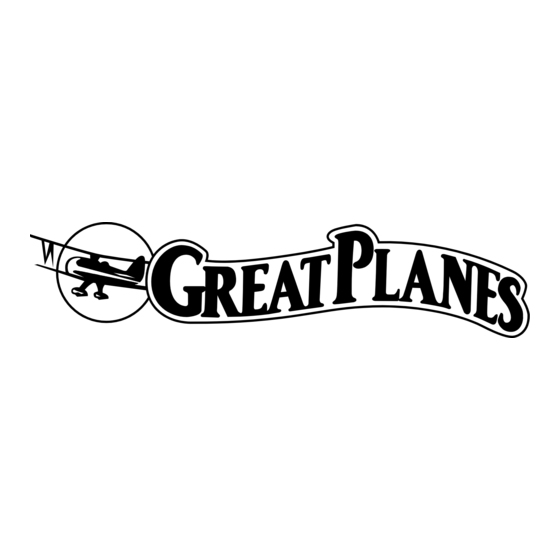GREAT PLANES SU-31 Manual de instruções - Página 12
Procurar online ou descarregar pdf Manual de instruções para Brinquedo GREAT PLANES SU-31. GREAT PLANES SU-31 16 páginas. Park flyers series

4. Connect a servo extension wire or "Y" harness to
the right aileron servo. Install the right aileron servo in its
mount using the grommets, eyelets and screws provided
with your servo. Enlarge the mounting area as needed to fit
your servo. Note: Be sure to route the servo wire through
the hole in the wing and out the bottom of the wing.
5. Using the same technique you did with the elevator,
install the aileron control linkage.
In the following step you will glue the wing into place on the
fuselage. Normally, you would use a string or tape measure
to align the wing with the fuselage. This will not work with this
model as the foam fuselage easily flexes, making alignment
using that technique difficult. This is one case where the
TLAR method (That Looks About Right) works best. The
center ribs of the wing also help in its alignment. Sight the
model from above, making sure the wing is not cocked
sideways. Sight the model from the rear to make sure the
wing is parallel with the stab (see page 9, step 4).
Caution: You will need to use paper towels and alcohol to
clean up any excess epoxy, but be very careful doing so.
The alcohol can dissolve the paint on the fuselage,
causing it to streak. Use a dry paper towel to clean the
fuselage. Use another paper towel, lightly dampened in
alcohol, to clean the wing. Be careful not to touch the
damp paper towel to the fuselage.
6. Insert the wing into the fuselage and glue it into place.
It is best to use 30-minute epoxy as it allows time to adjust
the wing, but if you use 6-minute epoxy, practice aligning the
wing before gluing it into place. Be careful not to use any
excess epoxy as cleanup can be difficult. Note: To spread
the epoxy, slide the wing about 1/2" [12.7mm] so that it is
slightly off center. Spread some epoxy on the wood of the
exposed wing rib, on the top and bottom of the rib. Then,
slide the wing so that it is 1/2" [12.7mm] off center in the
other direction and spread some epoxy on the other
exposed rib. If you are careful not to use an excess amount
of epoxy, there will not be much to clean up. It does not take
a lot of epoxy to hold the wing securely in place.
7. After the epoxy cures, return to step 3 and install the
left aileron, servo and control linkage.
GET THE MODEL READY TO FLY
Check the Control Directions
For safety, remove the propeller from the motor. Move the
throttle stick to the off position (towards you.)
Warning: Whenever the model is not being flown or setup,
the battery should be disconnected.
1. Connect a charged battery to the speed control. Turn
on the transmitter, then follow the instructions that came with
your speed control to turn on the receiver. Center the trims on
the transmitter. If necessary, remove the servo arms from the
servos and reposition them so they are centered. Reinstall
the screws that hold on the servo arms.
2. With the transmitter and receiver still on, check all the
control surfaces to see if they are centered. If necessary,
adjust the Screw-lock connectors on the pushrods to center
the control surfaces.
4-CHANNEL RADIO SETUP
(STANDARD MODE 2)
4-CHANNEL
TRANSMITTER
ELEVATOR MOVES UP
4-CHANNEL
TRANSMITTER
RIGHT AILERON MOVES UP
LEFT AILERON MOVES DOWN
3. Make certain that the control surfaces and motor
respond in the correct direction as shown in the diagram. If
any of the controls respond in the wrong direction, use the
servo reversing in the transmitter to reverse the servos
connected to those controls. Be certain the control surfaces
have remained centered. Adjust if necessary.
12
4-CHANNEL
TRANSMITTER
RUDDER MOVES RIGHT
4-CHANNEL
TRANSMITTER
FULL THROTTLE
